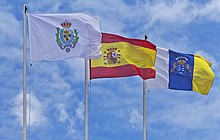The "Himno de Canarias" ("Anthem of the Canaries"), also known as the "Arrorró" ("Lullaby"), is the official anthem of the Canary Islands, Spain. The song was composed by Teobaldo Power. It was adapted as the community's anthem and incorporated as such on 30 May 2003.
| English: Anthem of the Canaries | |
|---|---|
 Flags of Santa Cruz de Tenerife, Spain and the Canary Islands | |
Regional anthem of | |
| Lyrics | Benito Cabrera |
| Music | Teobaldo Power |
| Adopted | 28 April 2003 |
| Audio sample | |
Official orchestral instrumental version | |
History
editThe anthem became official with Law 20/2003 of 28 April 2003. The Law begins with the following paragraph contained in the General Provisions: "Let it be known to all citizens that the Parliament of the Canary Islands has approved and I, on behalf of the King and in accordance with what is established in article 12.8 of the Statute of Autonomy, have promulgated and ordered the publication of Law 20/2003, of 28 April, of the Anthem of the Canary Islands."[1]
Until the implementation of the current anthem, a variation of the Arrorró from the Cantos Canarios by Teobaldo Power, there was an unofficial anthem (ONU) that was used in many functions and with which the Pasodoble Islas Canarias festivities were concluded.[2]
There is also an "Himno a Canarias" ("Hymn to the Canary Islands"), with lyrics by the Tenerife poet Fernando García Ramos and music by the Gran Canaria composer Juan José Falcón Sanabria,[3] commissioned by the first president of the autonomous community, socialist Jerónimo Saavedra.
After a debate in the Parliament of the Canary Islands, and with the contribution of new lyrics by Canarian musician Benito Cabrera to the "Arrorró" by Teobaldo Power, the official anthem of the Canary Islands was embodied in the aforementioned Law 20/2003.[1]
In January 2019, the government of the Canary Islands agreed to change the lyrics of the anthem from siete ("seven") to ocho ("eight") rocks, in recognition of La Graciosa,[4][5] which had become the eighth Canary Island in 2018, having previously been administratively dependent on Lanzarote.[6]
Lyrics
edit| Spanish original[1][4][5][7] | English translation |
|---|---|
Soy la sombra de un almendro, |
I am the shadow of an almond tree, |
See also
editNotes
editReferences
edit- ^ a b c "BOC - 2003/083. Viernes 2 de Mayo de 2003 - 714". Gobierno de Canarias. Retrieved 2022-01-07.
- ^ Ndez, Adalberto Afonso Fern; Afonso, Adalberto (2012). Mis investigaciones y aglo más: obras completas. Palibrio. p. 297. ISBN 978-1-4633-0712-7.
- ^ Canaria, Centro de la Cultura Popular (1997). Los símbolos de la identidad canaria (in Spanish). Centro de la Cultura Popular Canaria. p. 270. ISBN 978-84-7926-279-2.
- ^ a b c "El himno de Canarias cambiará para que hable de ocho islas". La Vanguardia (in Spanish). 2019-01-21. Archived from the original on 2022-01-07. Retrieved 2022-01-07.
{{cite web}}: CS1 maint: unfit URL (link) - ^ a b c "El himno de Canarias se transforma con la incorporación de La Graciosa". La Provincia - Diario de Las Palmas (in Spanish). 2019-01-21. Retrieved 2022-01-07.
- ^ Morris, Hugh (2018-06-28). "Nine fascinating facts about the newest Canary Island". The Telegraph. ISSN 0307-1235. Retrieved 2022-01-07.
- ^ "Himno de Canarias - Letra - Parlamento de Canarias". www.parcan.es. Retrieved 2022-01-07.